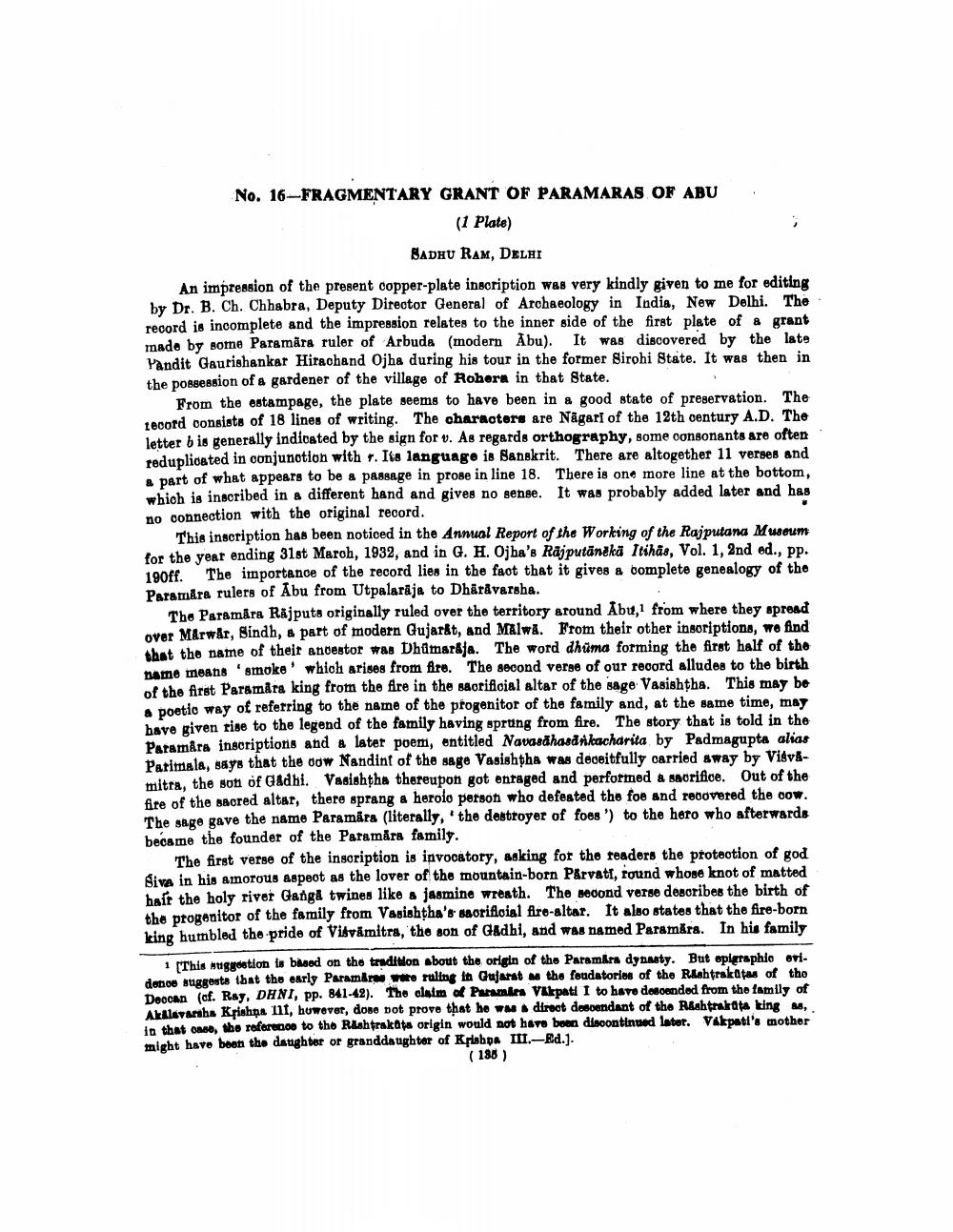________________
No. 16-FRAGMENTARY GRANT OF PARAMARAS OF ABU
(1 Plate)
BADHU RAM, DELHI An impression of the present copper-plate inscription was very kindly given to me for editing by Dr. B. Ch. Chhabra, Deputy Director General of Archaeology in India, New Delhi. The record is incomplete and the impression relates to the inner side of the first plate of a grant made by some Pargmāra ruler of Arbuda (modern Abu). It was discovered by the late Pandit Gaurishankar Hirachand Ojha during his tour in the former Sirohi State. It was then in the possession of a gardener of the village of Rohorn in that State.
From the estampage, the plate seems to have been in a good state of preservation. The tecord consists of 18 lines of writing. The characters are Nägarf of the 12th century A.D. The letter b is generally indicated by the sign for v. As regards orthography, some consonants are often redupliosted in conjunotion with r. Its language is Sanskrit. There are altogether 11 verses and & part of what appears to be a passage in prose in line 18. There is one more line at the bottom, which is inscribed in a different hand and gives no sense. It was probably added later and has no connection with the original record.
This inscription has been noticed in the Annual Report of the Working of the Rajputana Museum for the year ending 31st March, 1932, and in G. H. Ojha's Rajputanaka Itihas, Vol. 1, 2nd ed., pp. 190ff. The importance of the record lies in the fact that it gives a complete genealogy of the Paramra rulers of Abu from Utpalaraja to Dhårdvarsha.
The Paramāra Rajputs originally ruled over the territory around Abu,1 from where they spread over MÅrwÅr, Sindh, & part of modern Gujarkt, and MalwA. From their other inscriptions, we find that the name of their ancestor was Dhamaraja. The word dhuma forming the first half of the name means 'smoke' which arises from fire. The second verse of our record alludes to the birth of the first Paramára king from the fire in the sacrificial altar of the sage Vasishtha. This may be a poetio way of referring to the name of the progenitor of the family and, at the same time, may have given tise to the legend of the family having sprting from fire. The story that is told in the Patamara inscriptions and a later poem, entitled Navasähasdi kacharita by Padmagupta alias Parimala, says that the dow Nandint of the sage Vasishtha was deceitfully carried away by Vigvimitra, the son of Gadhi. Vasishtha thereupon got entaged and performed a sacrifice. Out of the fire of the sacred altar, there sprang a heroio person who defeated the foe and recovered the cow. The sage gave the name Paramära (literally, the destroyer of foes') to the hero who afterwards became the founder of the Paramära family.
The first verse of the inscription is invocatory, asking for the readers the protection of god Siva in his amorous aspeot as the lover of the mountain-born Parvatr, found whose knot of matted hair the holy rivor Gangå twines like a jasmine wreath. The second verse describes the birth of the progenitor of the family from Vanishtha's saorifloial firo-altar. It also states that the fire-born king humbled the pride of Visvämitra, the son of Gadhi, and was named Paramära. In his family
1 This wuggestion is based on the tradition about the origin of the Paramara dynasty. But epigraphio ovidance suggests that the early Paramaru e ruling in Gujarat m the foudatories of the Rashtraktas of the Deocan (of. Ray, DHNI, pp. 841-42). The claim of Paramie Vikpati I to have descended from the family of Allevara Krishna 111, however, dose pot prove that he wm direct descendant of the Rashtrakota king M, in that one, who reference to the Rashtrakata origin would not have been discontinued labor. VAkpati's mother might have been the daughter or granddaughter of Krishna III.-Ed.).
( 186 )




